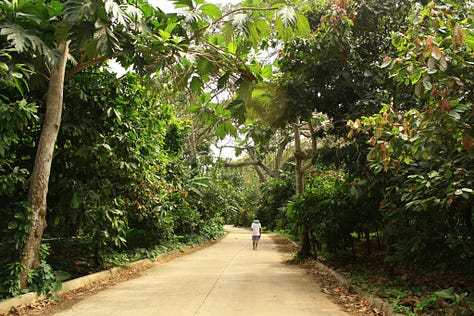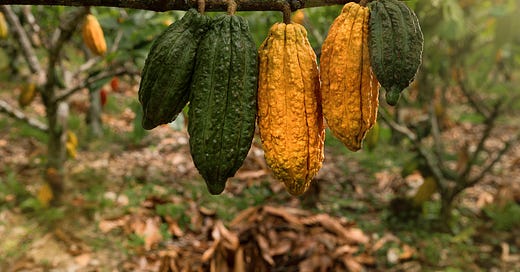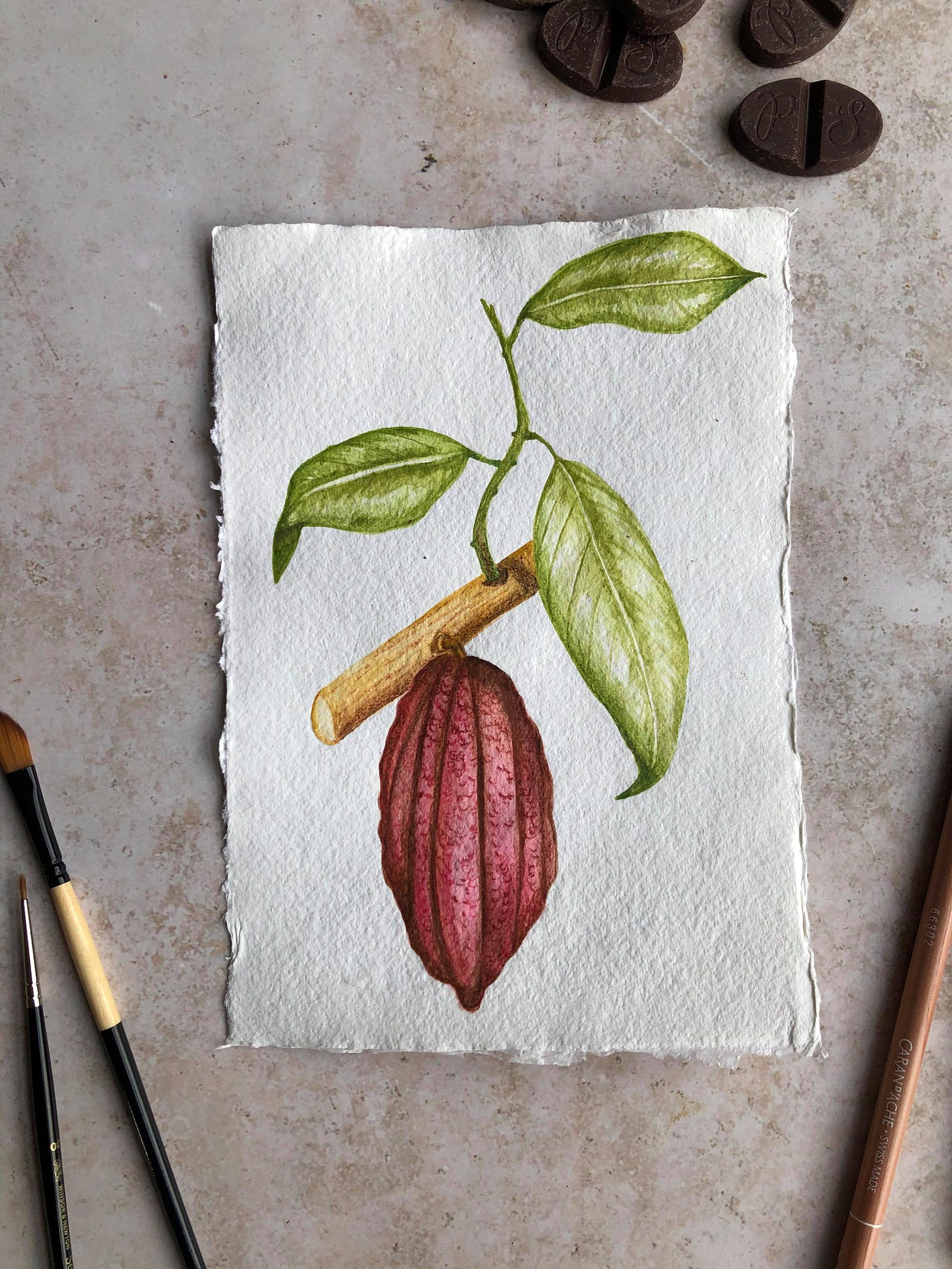I'm so sorry for the delay, but here is the newsletter from last week! I've been swamped lately and couldn't find the time to sit down and write. This newsletter is all about something very dear to me – chocolate. Last year, I started an MSc in Food Policy, and my dissertation focused on cacao production in the Ecuadorian Amazon. I've wanted to share my research in a more accessible, non-academic way and reach more people. I have so much to share, so I've decided to do a series of newsletters about this magical ingredient and tree, some with recipes and some without. I have tried to narrow it down to subjects because its history and cultural importance are impossible to describe in a few paragraphs. This week is all about colonialism in the chocolate industry, both past and present, and ways we can enjoy chocolate without the guilt of perpetuating colonialism.
I've been on trains a lot this week and enjoyed reading "The True History of Chocolate" by Sophie and Michael Coe. I thought it would be nice to share some of my favourite cacao and chocolate reads with you.
I'm feeling a mix of excitement and nervousness because, in a few weeks, I'll be presenting my research at the Oxford Food Symposium. The Julia Child Foundation has generously awarded me a grant, so I'll be there in person, enjoying an exciting weekend in Oxford. Wish me luck!
In the summer of 2012, I travelled to Venezuela with two friends and my boyfriend, we planned to visit the Salto del Angel, the tallest uninterrupted waterfall in the world. But Venezuela had other plans for us and we ended up in Chuao. Several years later, when I started cooking more and decided to train as a pastry chef I discovered that Chuao was a place with a deep history of cacao production. I was so upset (and still am) that I didn’t know and could not discover the place with the eyes of a chocolate researcher.



Even though I didn’t know about Chuao’s history with cacao, I regard this memory as the moment that my curiosity regarding cacao and chocolate started. After that trip, I continued studying law and on the side, I was working as a self-trained pastry chef, but before I knew it I moved to Paris to train professionally in patisserie. We moved to the UK and in 2019 I trained as a chocolatier and chocolate maker in Barcelona, alongside Greg D’Alessandre from Dandelion Chocolate and the brilliant team of the EPGB. Then COVID happened and like most people, I started to question my career choices. This led me to pursue an MSc in Food Policy and of all things, my dissertation was about chocolate. In particular, about cacao produced in Chakras, an indigenous agroforestry system in the Ecuadorian Amazon region.
As years pass I have become more obsessed with chocolate and the role I play as a Pastry Chef. As Alicia Kennedy wrote in her essay about luxury:
“There’s no reason why chocolate—all chocolate—shouldn’t be understood as a luxury, with diverse expressions of cacao terroir named, respected, discussed. But that only happens in the smallest of forums, and it’s mocked in the general culture to care about such things as chocolate, or coffee, or sugar. I’ve said it before, but people who would generally claim to care about matters of social justice or decolonization turn the other way when it comes to the commodities upon which their days and pleasures are built. They would prefer the land be exploited somewhere else rather than understand most of what they eat as a luxury, to be regarded as preciously as the August tomato or the wildly priced truffle tasting menu at a fine-dining restaurant.”
She was able to put in words how I have been feeling for a while… I felt mocked for caring about chocolate as a product that has an origin, people, nature and a value chain that is constantly disregarded. However, chocolate history cannot be told without explaining the history of slavery, colonization, of inequality in contemporary commodity production. So recently I have understood that my approach is to basically bait people with delicious chocolate and then switch to talking about these issues. Because, chocolate has been my entry point to think about supply chain issues, trade issues, commodification of food and the role of slavery in the past and the present in food systems.
Why is chocolate relevant in food systems?
Chocolate transcends borders and offers insights into both past lives and our current state.1 Today, chocolate is a commodity, traded on the stock markets in New York and London, where its price is determined. The production of bulk cacao for the commodity market prioritizes yield and profit over flavour, farmers’ livelihoods, and biodiversity preservation. The chocolate industry has a history of and continues to grapple with poor labour conditions and the legacy of colonialism. How did we arrive at this point, and what can be done to address it?
As always, the answers are complex. The stock markets are far removed from the origins of cacao domestication in the northern Amazonian basin of South America. Before European arrival, cacao beans held significant political and cultural value in Mesoamerican civilizations. However, the way cacao was consumed in its place of origin was initially unappealing to Europeans; it was bitter, thick, and, as described by Benzoni in 1565, “distasteful to the point of nausea.”2 Yet, the concept of cacao as currency greatly appealed to Europeans, especially during a period of economic instability.
Colonialism in chocolate production
Harvesting and processing cacao is an arduous task, and the indigenous peoples of Mesoamerica struggled to meet the surging European demand. The Spanish conquest had devastating effects on the native population, with European diseases wiping out over 90% of some indigenous communities in Latin America. As cacao grew scarcer, the Spanish resorted to the encomienda system, a brutal form of forced labour that quickly devolved into slavery. Indigenous people were ruthlessly exploited, and compelled to cultivate cacao to satisfy European appetites.
In the 17th and 18th centuries, other colonial powers—Portugal, England, France, and the Netherlands—followed Spain's lead. As globalization expanded, the cacao supply chain stretched across the globe. The crop was introduced to Southeast Asia and West and Central Africa, transforming these regions into major centres of cacao cultivation. This spread not only facilitated the global chocolate trade but also entrenched a legacy of exploitation and inequity that still echoes today.
Imperial powers increasingly relied on goods produced by enslaved laborers, transforming the original cacao-growing regions in the Americas and new cultivation areas, mostly in West Africa and São Tomé Island into wealth extraction sites controlled by European crowns.
Chocolate globalisation
Colonization brought profound changes to cacao production, establishing international trade routes in the 1800s that favoured wealthier nations and created imbalanced power dynamics.3 The impacts of industrialization and globalization further transformed both production and consumption patterns. Today, most cacao production occurs in West Africa, a result of globalization spreading cultivation across its viable growing zones.
Pioneering companies like Lindt, Nestlé, Cadbury, Hershey’s, and Mars revolutionized industrial chocolate production to achieve scalability. They introduced major changes, such as blending beans and standardizing formulations, to ensure consistent taste with every purchase. This approach marked a departure from historical chocolate experiences.4
Additionally, controlling the supply chain became increasingly important to avoid production interruptions. Over time, the industry shifted dramatically, with large chocolate manufacturers becoming the primary producers of the world's chocolate, exerting significant influence over the entire supply chain.
Today, the commodity chocolate value chain can be visualized as an hourglass-shaped supply chain. Ninety per cent of the world’s cacao is grown by smallholders who receive a small fraction of the financial value, while a few large companies capture most of the profit, on the other end, millions of consumers enjoy the final product.
Since the 1990s, the cacao trade has been part of a global trend where the links between food and finance have grown increasingly complex. The financialization of the food system has widened the gap between producers and consumers, involving more financial actors. Cacao smallholders are trapped in a cycle of low yields and prices while bearing the most risk.
Numerous scholars have highlighted the diminishing financial value retained by smallholders in commodified agricultural value chains. In the 1970s, cacao farmers retained 60% of the financial value of their products. By the 2000s, this value had dropped to 20%, and by 2015, it had plummeted further to just 4-6%.5
What can we do?
Addressing these issues requires a concerted effort, substantial resources, and strong political will. As individuals and chocolate consumers, we can collectively work to understand the long socio-historical roots of the industry’s challenges, including biodiversity loss in cacao-producing regions, low incomes for farmers, and the persistence of child labour in certain regions.
Advocacy from grassroots movements is increasingly vital. Those who love, cook with, and enjoy chocolate must unite to demand change. Consumers need to be willing to pay more for both certified and uncertified chocolate. Certification schemes should support farmers and cooperatives by minimizing costs while prioritizing accountability to uphold social and environmental ethics and avoid empty rhetoric. Consumers now have more resources and access to information than ever before, we can use this to our advantage. The Chocolate Score Card ranks and grades chocolate companies on key sustainability issues, maybe when purchasing your next bar if you are in doubt take a look. Even better, if you can support small independent bean-to-bar chocolate makers who give you access to their information on origins and traceability.
We must decommodify the cacao market. It's no longer acceptable to hide behind the excuse that “this is how the market works.” New systems must be developed that operate independently of traditional market forces. According to the Cocoa Barometer report the approach could involve producer governments decoupling cocoa prices from the commodity exchange market and setting them based on production costs, ensuring a living income for farmers.6
Everyone is involved in our food system, from farmers to consumers. All of us will play a role in finding solutions to its problems. Chocolate has the power to bring people together at local and global levels, giving us insight into the past, present, and future.
Martin, Carla, and Kathryn Sampeck. "The bitter and sweet of chocolate in Europe." Socio. hu Társadalomtudományi Szemle (2015): 37-60.
Benzoni, Girolamo. La historia del mondo nuouo. ad instantia di Pietro [e] Francesco Tini, fratelli, 1962.
Leissle, Kristy. Cocoa. John Wiley & Sons, 2018.
Coe, Sophie D., and Michael D. Coe. The true history of chocolate. Thames & Hudson, 2013.
Abdulsamad, Ajmal, et al. "Pro-poor development and power asymmetries in global value chains." Duke University, Center on Globalization, Governance and Competitiveness (Duke CGGC). Doi: https://doi. org/10 13140 (2015).
Cocoa Barometer, VICE, (2022).







I started working for Oxfam with a mission to help poor people and poor farmers and that's how I got interested in chocolate. If nothing else, it's one of the only ways a normal person in the global north is connected to the lives of poor people in the global south (also coffee, coconut, cotton) and a way to tell the story. Thanks for writing - I'll subscribe to read more.
Thank you for sharing this article!